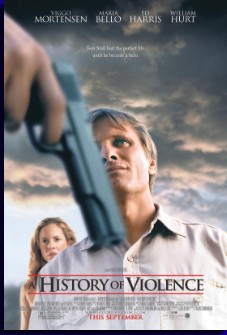




Reviewed by
Bud Carlson

“I thought I was out, but they pulled me back in” was one of the most interesting lines in any of The Godfather movies. Some people think they can join the mob and live the life, and then walk away at their own convenience. But alas, that’s not the way it works. Just ask Tom Stall, the main character from A History of Violence.
Tom Stall (Viggo Mortensen) is a mild-mannered gentleman from Millbrook Indiana, the owner and manager of the local diner there. He is the loving husband of the very passionate Edie (Maria Bello), and devoted father to teenage son Jack (Ashton Holmes) and little daughter Sarah (Heidi Hayes). The Stall’s small-town life is so idyllic, and their togetherness so complete, that when daughter Sarah has a bad dream about monsters, the entire family winds up in her room to comfort her and help her back to sleep. Yes, it’s that quiet in Millbrook, Indiana.
But that all changes in one night. Two serial killers enter the diner at closing time, intending harm for the patrons and staff. We met these thugs in the film’s introduction, when they created a bloodbath at a motel earlier that day. We know they intend not just to rob Tom’s diner, but to ruthlessly kill everyone in it. Tom doesn’t have the background on these guys, but he figured it out quickly, and springs into action. He acts heroically, killing both villains swiftly and efficiently, and saving the day.
Tom’s heroics bring him attention, both local and national, wanted and unwanted. On one hand, he seems moderately satisfied to be the lead story on all the local news broadcasts. And the diner, previously sparsely attended, is now packed with customers. But Tom seems to be a naturally genteel and quiet man, and he’s reluctant to want to talk about it too much, saying he is looking forward to things returning back to normal.


Another day, three men enter the diner, and they are clearly not locals to Millbrook. They have East Coast accents and wear slick suits. They must have seen the news stories of Tom’s heroics. They call Tom by the name Joey, say that they remember him from his days in Philly years ago, and suggest that he is not who he says he is. He calmly tells them they’ve got the wrong guy. But the leader of the three, played by Ed Harris, asks the million-dollar question: If he is just Tom Stall, then “how come he’s so good at killing people.”
Ah, good question. How could someone as ordinary as Tom behave so violently, not to mention so efficiently? And are we, the audience, so inured to movie violence that when it happens, we don’t even question it? And this question begins to eat away at Edie, who loved Tom so entirely and passionately at the beginning of the movie, but now seems to be getting squirrelly about the whole incident, and begins to question him in her own mind.
These three mobsters from Philly won’t go away. They hang out in their car and watch Tom at work, and they follow Edie and Sarah to the mall (in what, for any parent, was quite a frightening scenario). They come to the Stall house, having nabbed Jack, and try to coerce Tom into returning to Philly with them. But Tom, with a little help, takes the three mobsters apart with brutal efficiency. It seems that Tom really is Joey after all … Joey from Philly.
But things aren’t quite right among the Stall family. Edie now realizes that Tom has been lying to her all these years, and that she has been living with a man she doesn’t even know (and all that romantic-novel babble). Remember Edie’s sensuality from the beginning of the movie? Well, it has now been replaced with or balanced by her animalistic attraction to, and simultaneous repulsion from, Joey (Tom’s newly-found violent streak). It’s disgusting, but yet it turns her on. What’s hotter than a powerful man who can protect her from evil-doers?
Probably the most interesting aspect of the film is to see what Tom has put his family through, and how they react to it. I have already mentioned Edie’s reaction to all of these events at each stage of the movie, but the development of the son Jack is noteworthy as well. At first, Jack is totally reluctant to want to defend himself against a bully at school, choosing to denigrate himself instead of fighting. But in a scene a bit later (after the “my dad’s a hero” incident at the diner), he stands up for himself against that same bully, and kicks his ass in a pretty vicious fashion. And in an even later scene, when the mob comes to the Stall house, and the Ed Harris character gets the drop on Tom, it is the oldest son who saves Tom’s ass by blowing a shotgun hole through Harris’ chest. Quite the evolution, this is obviously not the same kid from the beginning of the film.
A History of Violence has a point to make, and it makes it without hitting us over the head with it. The movie is absorbing and exciting, with secrets and surprises and twists unexpected. Viggo Mortensen is unflappable as Tom, capturing an interesting aspect to a once-bad man. This movie really is as the title states, a story about violence, and the lives it affects. Contrary to what you see in every other Hollywood movie, you don’t kill a guy and watch him die bloodlessly. There are ramifications. As the result of Tom killing those two murderers, three more appear at his doorstep. And later, once those three are dispatched, there are five more. And you can’t join the mob (as Joey did back in Philly) and then walk away, it’ll catch up to you eventually. That is why I believe the final scene of the movie was as unsettling and unsatisfying as it was.